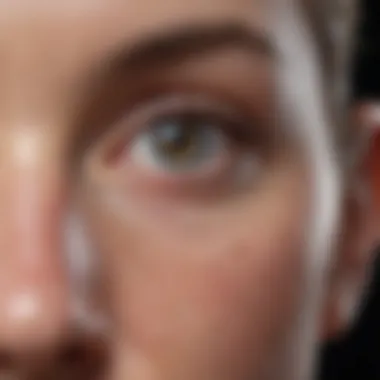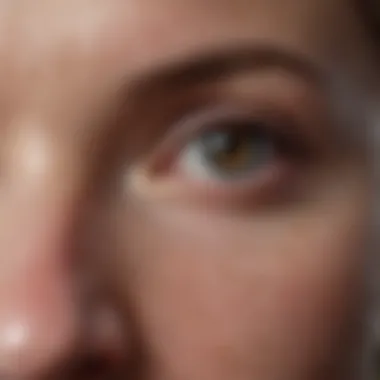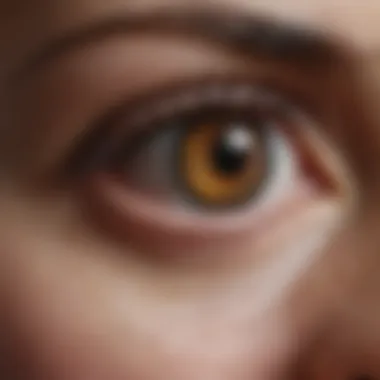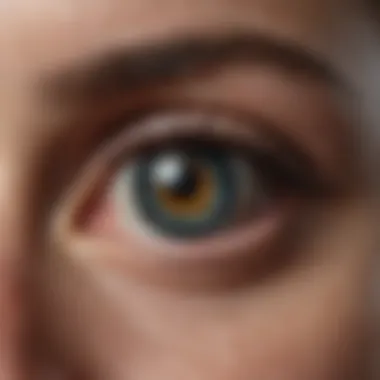Breakthroughs in Wet Macular Degeneration Treatments 2020


Intro
Wet macular degeneration is a leading cause of vision loss among older adults. It occurs when blood vessels in the retina leak fluid or bleed, leading to damage in the macula, the part responsible for sharp vision. Understanding the advancements in treating this condition has become increasingly crucial. In 2020, significant strides were made in developing new therapeutic methods, which can profoundly impact patient outcomes and quality of life.
The increasing prevalence of wet macular degeneration worldwide highlights the urgent need for better treatment options. Research in this area has focused on not only addressing the symptoms but also understanding the underlying mechanisms that contribute to the disease. With an aging population, the complexities of wet macular degeneration warrant continuous exploration and innovation in treatment approaches.
Preface to Wet Macular Degeneration
Wet macular degeneration (WMD) represents a significant ocular condition that has implications for millions globally. As a leading cause of vision loss, understanding this disease is not merely academic; it informs treatment decisions and enhances patient quality of life. This article explores the recent breakthroughs in treatment strategies, focusing on advancements made in 2020. Such developments are crucial, considering the challenges that WMD presents to both patients and healthcare providers.
Understanding Wet Macular Degeneration
Wet macular degeneration occurs when abnormal blood vessels grow under the retina, leading to leakage of fluid and blood. This affects central vision, which is essential for everyday tasks like reading and driving. The progression of the disease can be rapid, resulting in significant visual impairment if not diagnosed and treated promptly.
Establishing a clear understanding of WMD begins with recognizing its symptoms. Common early symptoms include distortion of straight lines, blurred vision, and dark spots in central vision. Patients may not notice changes until the condition has advanced. The need for early detection and treatment is paramount, and that is where advancements in medical science play a vital role.
Epidemiology and Risk Factors
The prevalence of wet macular degeneration has been on the rise. It primarily affects older adults, often those over 50 years of age. Various studies indicate that risk factors include genetic predisposition, advanced age, and a history of smoking. In addition, individuals with lighter eye colors and those who have cardiovascular diseases face higher risks.
Research highlights the importance of recognizing these risk factors for preventative measures. Regular eye examinations for at-risk groups can lead to earlier diagnosis and intervention. Studies show that lifestyle modifications, particularly diet and exercise, can also play a role in reducing the incidence of WMD.
"Recognizing risk factors empowers individuals to take action for better eye health."
To summarize, understanding wet macular degeneration provides insight into its impact on individuals and society. This insight is necessary to appreciate the importance of treatment breakthroughs discussed later. The scope of the disease emphasizes the need for continued research and innovation in treatment strategies.
The Pathophysiology of Wet Macular Degeneration
Understanding the pathophysiology of wet macular degeneration is crucial for grasping how recent treatment breakthroughs tackle the disease. This section delves into the underlying mechanisms that give rise to wet macular degeneration, providing essential context for the novel therapies developed in 2020. By exploring the vascular changes and inflammatory processes instrumental in this condition, we can better appreciate the significance of advancements made in patient care and treatment strategies.
Vascular Changes in the Retina
Wet macular degeneration is characterized by abnormal vascular changes within the retina. The formation of new blood vessels, or choroidal neovascularization, is a hallmark feature that directly contributes to vision loss. These vessels are often fragile and leak fluids and proteins, causing retinal edema and disruption to the retinal pigment epithelium. This damage leads to the accumulation of subretinal fluid, resulting in distortion or blurring of vision, which is particularly problematic for tasks requiring sharp eyesight.
Several factors trigger these vascular changes. The most notable is vascular endothelial growth factor (VEGF), which plays a central role in angiogenesis. Increased levels of VEGF are observed in the retinas of individuals with wet macular degeneration, highlighting its critical involvement. Targeting this pathway has become the focus of many therapeutic approaches, especially anti-VEGF therapies designed to inhibit abnormal vessel growth. Understanding the dynamics of these vascular changes informs us about potential therapeutic targets and the long-term implications of such treatments.
Role of Inflammation
Inflammation is another pivotal factor in the development and progression of wet macular degeneration. The immune response contributes to tissue damage and disease progression through a complex interplay of cytokines, chemokines, and immune cells. Inflammation can exacerbate the pathology by facilitating further vascular changes and leading to additional retinal damage.
Research has indicated that chronic inflammation may result from the accumulation of drusen, which are yellowish deposits found beneath the retina in people with age-related macular degeneration. This inflammatory environment not only promotes neovascularization but also disrupts the normal homeostasis of retinal cells. Additionally, the involvement of immune pathways in vision impairment highlights the importance of anti-inflammatory strategies as complementary approaches in treatment formulations.
The breakthroughs in 2020 have underscored the necessity of addressing both the vascular and inflammatory components in wet macular degeneration. These insights help shape emerging therapies that aim not only to mitigate symptoms but to target the root causes of the disease. An integrated understanding of the pathophysiology thus serves as a foundation for the advancement of effective treatments.
Current Treatment Strategies
The treatment of wet macular degeneration (WMD) remains crucial in mitigating the progression of this debilitating ocular condition. Current strategies focus primarily on controlling the growth of abnormal blood vessels beneath the retina, which characterizes WMD. This section highlights two major treatment modalities: anti-VEGF therapy and photodynamic therapy. Both of these approaches bring unique benefits, considerations, and advancements that enhance patient care in 2020.
Anti-VEGF Therapy Overview
Anti-vascular endothelial growth factor (anti-VEGF) therapy has become the cornerstone of treatment for wet macular degeneration. This approach specifically targets VEGF, a protein responsible for the growth of abnormal blood vessels in the retina. By inhibiting this factor, anti-VEGF agents help to reduce fluid leakage and swelling in the macula, leading to improved vision.


This therapy is commonly administered through intravitreal injections, with several agents already available, such as ranibizumab and aflibercept. The efficacy of these agents has been demonstrated in multiple clinical trials, leading to significant visual acuity improvements in many patients.
However, it is essential to weigh the benefits against potential risks, including ocular discomfort and the possibility of complications such as endophthalmitis. Furthermore, the required frequency of injections can be a burden for patients, highlighting the need for ongoing research into extended-release formulations and alternative delivery systems.
"Anti-VEGF therapy has transformed the landscape of WMD treatment, but patient adherence remains a challenge."
Photodynamic Therapy
Photodynamic therapy (PDT) offers a different approach to treating wet macular degeneration. This technique uses a photosensitizing agent, typically verteporfin, combined with low-intensity laser light. When the drug is activated by the light, it generates reactive oxygen species targeting abnormal blood vessels. This process leads to vessel closure and reduced leakage.
PDT is particularly relevant for patients who may not respond adequately to anti-VEGF agents. Its mechanism allows for treatment in cases where those agents have failed or when patients cannot tolerate the injections due to various health reasons. The key advantage of PDT is its ability to selectively target and reduce pathological vessels while sparing healthy tissue.
Nevertheless, photodynamic therapy is not without its own set of challenges. Patients often experience side effects such as photosensitivity and visual disturbances following treatment. Additionally, PDT is not as widely recognized as first-line therapy compared to anti-VEGF treatments, indicating a potential need for widespread education regarding its benefits and appropriate use.
In summary, understanding current treatment strategies is pivotal for professionals involved in the care of patients with wet macular degeneration. Anti-VEGF therapy remains the frontline approach, although photodynamic therapy provides an important alternative for specific cases. These strategies continue to evolve, with research seeking to optimize both efficacy and patient compliance.
Breakthrough Treatments in
The year 2020 marked a significant turning point in the treatment landscape for wet macular degeneration. As this condition remains one of the leading causes of irreversible vision loss, innovations in therapy offer renewed hope for patients. The developments made during this period focused on enhancing treatment effectiveness, minimizing side effects, and improving patient adherence.
Gene Therapy Developments
Gene therapy represents a frontier in the treatment of wet macular degeneration, aiming to address the underlying causes of the disease at the genetic level. In 2020, researchers advanced several trials targeting specific genes associated with the pathophysiology of the disease.
One notable development was the use of adeno-associated virus vectors to deliver therapeutic genes directly to the retina. This method shows promise in restoring or preserving vision by promoting the expression of proteins that can prevent vascular leakage, a hallmark of wet macular degeneration. Early studies indicated that patients experienced stabilization or even improvement in visual acuity, offering a potential long-term solution compared to traditional therapies.
New Anti-VEGF Formulations
Anti-VEGF (vascular endothelial growth factor) therapies have been a cornerstone in treating wet macular degeneration. In 2020, several new formulations emerged, aiming to provide prolonged efficacy and reduced treatment frequency.
Among these formulations, the introduction of bimonthly dosing regimens for drugs such as Aflibercept and Ranibizumab was highlighted. These advancements are essential as they can increase patient compliance and decrease the burden of frequent injections. Early clinical trials suggested that these new treatments not only maintained visual stability but also improved patient-reported outcomes, paving the way for a more manageable therapeutic approach.
Emerging Combination Therapies
Combining therapies has become a critical strategy in managing wet macular degeneration effectively. In 2020, several studies explored the synergistic effects of combining anti-VEGF agents with corticosteroids, photodynamic therapy, or novel agents targeting inflammatory pathways.
Such combination therapies aim to address not only the angiogenesis characteristic of wet macular degeneration but also the inflammation that contributes to retinal damage. Clinical trials indicated enhanced outcomes regarding visual acuity and a reduction in the need for subsequent treatments. This strategy emphasizes a more holistic approach to treatment, addressing multiple disease pathways simultaneously.
"The integration of combination therapies opens new doors for patient management, emphasizing the importance of a tailored approach to treatment."
These advancements from 2020 provide a glimmer of hope in the battle against wet macular degeneration, highlighting the dynamic nature of ongoing research and clinical innovation. As these therapies continue to evolve, they promise to reshape patient care and improve quality of life significantly.
Clinical Trials and Research Results
Clinical trials are a cornerstone in the advancement of treatments for wet macular degeneration. They provide essential data on the safety and effectiveness of new therapies. This section discusses the notable trials conducted in 2020, which served as a crucial validation platform for groundbreaking treatments. The results of these studies shaped future approaches in managing the disease and offer insights into practical applications.
Notable Trials Conducted in
In 2020, several clinical trials brought forward significant findings regarding the treatment of wet macular degeneration. Some trials focused on gene therapy, while others explored novel formulations of existing treatments. Noteworthy among these was the AVASTIN clinical trial, which evaluated the efficacy of the drug in patients showing resistance to standard anti-VEGF treatments.
Another important trial was the RT58 study, assessing a new anti-VEGF injection that promises longer-lasting effects compared to traditional options. The results indicated that patients might require fewer injections annually without compromising visual acuity.


Moreover, the KESTREL trial investigated a combination of anti-VEGF therapy and photodynamic therapy. This study aimed to understand whether simultaneous administration could enhance outcomes for patients with advanced symptoms.
Key Findings and Implications
The findings from these trials are pivotal for multiple reasons. First, the studies underscore the importance of continuous innovation in treatment. For example:
- The AVASTIN trial demonstrated that modifying existing therapies can benefit patients who do not respond to initial treatments.
- RT58 suggested that reducing the frequency of injections can improve adherence to treatment, a common challenge in chronic care.
- The KESTREL trial highlighted the potential of combination therapies, which may become a standard approach in clinical practice.
Clinical trials not only introduce new therapies but also provide a glimpse into the future of treatment protocols.
These insights lead to significant implications for healthcare providers. They must stay abreast of ongoing research to offer the most current options to their patients. Furthermore, understanding the variability in treatment response encourages a more tailored approach to patient care.
In summary, the clinical trials of 2020 offered a wealth of information. They tested the limits of current therapies and revealed new possibilities for improved patient outcomes in the context of wet macular degeneration.
Future Directions in Wet Macular Degeneration Research
The understanding and treatment of wet macular degeneration continue to evolve. The focus is shifting towards innovative research methods and personalized treatment approaches. Addressing this topic is crucial as it captures the essence of progress and the need to adapt solutions to individual patients' needs. Within this section, we will discuss investigating combination approaches and the potential for personalized medicine. Both areas promise significant advancement in managing wet macular degeneration effectively.
Investigating Combination Approaches
Combination therapies may leverage the strengths of multiple treatment modalities. For wet macular degeneration, combining different mechanisms can lead to enhanced effectiveness. For instance, recent studies have explored pairing anti-VEGF therapies with ocular steroid injections. The goal is to reduce inflammation while also inhibiting abnormal blood vessel growth. This dual effect could improve visual outcomes for patients.
A handful of clinical trials have started to investigate the impact of combining these therapies. Early results from these trials show promising improvements in patients' visual acuity and a reduction in treatment frequency. This is particularly important as many patients struggle with the burden of regular injections. Reducing the number of visits can improve adherence to treatment plans and ultimately enhance quality of life.
- Combination therapies might also reduce the risk of resistance to a single treatment.
- Customizing treatment plans based on individual responses can optimize results.
Potential for Personalized Medicine
Personalized medicine represents a paradigm shift in healthcare. It involves tailoring medical treatment to individual characteristics, needs, and preferences. In the context of wet macular degeneration, this means acknowledging the unique biological factors that influence disease progression in each patient. Genomic studies and biomarker research are paving the way for more effective personalized strategies.
The implementation of personalized treatment regimens entails understanding genetic predispositions and variations in drug metabolism. By knowing which patients are likely to benefit from specific treatments, doctors can minimize trial-and-error approaches and improve outcomes.
Considerations for personalized medicine include:
- Patient-specific factors: Age, overall health, and genetic makeup can affect treatment responses.
- Pharmacogenomics: Understanding how a patient's genetic profile influences drug efficacy and safety can guide therapeutic choices.
- Monitoring and adaptation: Continuous assessment of treatment effectiveness will be critical to adjusting therapies appropriately.
The potential benefits of personalized medicine could revolutionize how wet macular degeneration is treated, fundamentally shifting the approach from a one-size-fits-all to a more nuanced, tailored method.
Challenges in Treatment Accessibility
Accessibility to treatment for wet macular degeneration is a pressing concern in the modern healthcare landscape. Improving treatment outcomes for patients does not only hinge on advancements in medical research or the development of innovative therapies. Rather, it involves considering the multifaceted barriers that patients encounter in real-world settings.
Among these challenges, socioeconomic factors often emerge as significant determinants. Patients may face financial hurdles, including the high costs of medications and associated therapies. Even with insurance coverage, out-of-pocket expenses can be prohibitive. Many individuals may prioritize basic needs over healthcare, leading to detrimental choices regarding their treatment. Even individuals with sufficient insurance may face difficulties due to high deductibles or non-covered expenses associated with specialized care.
Moreover, the distribution of resources such as clinics and specialists affects accessibility. Patients residing in rural or underserved urban areas may find themselves traveling long distances to access necessary treatments. This can lead to delays in receiving care, which may exacerbate the progression of wet macular degeneration and ultimately affect the quality of vision in patients.
Socioeconomic Barriers
Socioeconomic barriers significantly affect treatment choices for wet macular degeneration. These barriers encompass various elements such as income, education, and employment status. Low-income households may face limitations in managing healthcare costs, resulting in postponed or skipped treatments. Additionally, lower levels of education can lead to reduced health literacy. This affects patients’ understanding of their condition and the importance of adhering to prescribed therapies.
In many instances, patients may not fully grasp how crucial timely intervention is in the context of wet macular degeneration treatment. For instance, anti-VEGF injections are often vital in managing the condition, but the costs associated with these injections can deter patients from seeking timely care.


"Patients living below the poverty line are often prone to worse outcomes due to unaddressed visual impairments."
Healthcare Infrastructure Limitations
Healthcare infrastructure also presents a formidable challenge in treatment accessibility. Many facilities lack the specialized ophthalmology services required for treating wet macular degeneration. In some areas, the few available specialists may be overwhelmed, leading to long waiting times for appointments.
This is particularly troublesome for new patients who need immediate evaluation and treatment. Moreover, telemedicine has emerged as a useful tool in addressing some access issues, but not all patients have the technical skills or internet access necessary to benefit from these services.
Consequently, system-wide reforms are necessary to enhance both clinic capacity and accessibility to innovative treatments. The integration of additional funding, training, and outreach programs could alleviate some of these barriers, fostering an environment where more patients can receive timely and effective care.
Overall, understanding the challenges linked to treatment accessibility is crucial in furthering the discourse around wet macular degeneration. Addressing these barriers can potentially improve patient outcomes and increase the efficacy of new and existing treatment options.
Patient Perspectives and Quality of Life
The experience of individuals living with wet macular degeneration extends beyond the clinical aspects of this condition. Patient perspectives and overall quality of life become crucial components in understanding how treatment breakthroughs impact everyday living. Recent advancements in treatment often focus on clinical efficacy. However, neglecting the patient experience can lead to misconceptions regarding the true value of these therapies.
Wet macular degeneration can severely hinder one's ability to perform daily tasks. Patients may find it challenging to read, recognize faces, or even navigate their environments. Such vision loss not only diminishes independence but can also lead to emotional distress. It is essential to integrate patient experiences into the evaluation of treatment effectiveness. Understanding how treatments translate into improved quality of life is critical for healthcare providers.
Impact of Vision Loss on Daily Life
Loss of vision due to wet macular degeneration impacts various dimensions of daily life. Activities considered routine can become significantly challenging. For example, tasks like cooking or shopping require visual acuity that may become impaired. Loss of independence is a common sentiment among patients. Many express feelings of frustration and helplessness.
Furthermore, emotional consequences accompany vision loss. Patients experience anxiety and depression at higher rates compared to the general population. Rehabilitation and coping strategies are vital in addressing these mental health challenges. Many patients benefit from low-vision rehabilitation programs that offer resources for adapting to changes in vision. These programs teach individuals how to utilize remaining vision effectively, fostering a sense of resilience and agency.
Importance of Support Systems
The role of support systems cannot be overstated. Friends, family, and community resources provide essential emotional and practical support. Understanding these elements can greatly enhance the quality of life for individuals with wet macular degeneration. Peer support groups offer an avenue for sharing experiences and strategies, creating a sense of community among individuals facing similar challenges.
Healthcare providers should encourage patients to engage with support networks. Involving family members in discussions about treatment options can also drive better adherence to prescribed therapies. Patients who have robust support systems are likely to experience better outcomes.
"The journey through vision loss can feel isolating, but it's essential to remember that help is available. Engaging with supportive individuals can make a significant difference."
While medical advancements are vital, integrating patient perspectives ensures that those advancements genuinely enhance quality of life. As the research continues, attention to the lived experiences of patients will shape more comprehensive treatment strategies.
End
The significance of wet macular degeneration (WMD) treatment breakthroughs in 2020 cannot be overstated. This article provides a comprehensive analysis of the key advancements made in this field. Focused on innovations in treatment protocols, it highlights how these developments have positively influenced patient care. Each treatment method discussed earlier holds promise not only for managing symptoms but also for improving overall quality of life for individuals affected by this condition.
Summary of Key Advances
In 2020, several notable advancements in WMD treatment emerged. Key developments include:
- Gene Therapy Developments: Novel gene therapies offered potential long-term solutions for the underlying causes of WMD, aiming to reduce dependency on ongoing treatments.
- New Anti-VEGF Formulations: Enhanced formulations showing better efficacy and fewer side effects compared to existing therapies. These could change how commonly anti-VEGF medications are utilized.
- Emerging Combination Therapies: Strategies that synergize different therapeutic approaches. These therapies address multiple angles of WMD, potentially enhancing treatment outcomes.
These advances reflect a concerted effort across the medical community to address the challenges faced by individuals with WMD.
The Path Forward for Research and Treatment
Looking ahead, research in the realm of WMD must focus on several key areas. Studying the effectiveness of combination therapies further could yield valuable insights. Understanding how diverse treatments interact will be crucial in refining patient management strategies.
Additionally, the potential for personalized medicine should be explored more thoroughly. Adapting treatments based on patient-specific factors promises to enhance treatment efficacy and reduce unnecessary risks or side effects.
The collaboration of researchers, healthcare providers, and patients will be vital. This close cooperation can lead to breakthroughs that not only improve existing treatments, but also pave the way for innovative solutions in the future.
"In 2020, the advancements in wet macular degeneration treatment represented not just scientific achievements, but also hope for millions impacted by the condition."
As we move forward, the ongoing exploration of these areas will be instrumental in defining effective, safe, and patient-centered approaches to managing wet macular degeneration.



